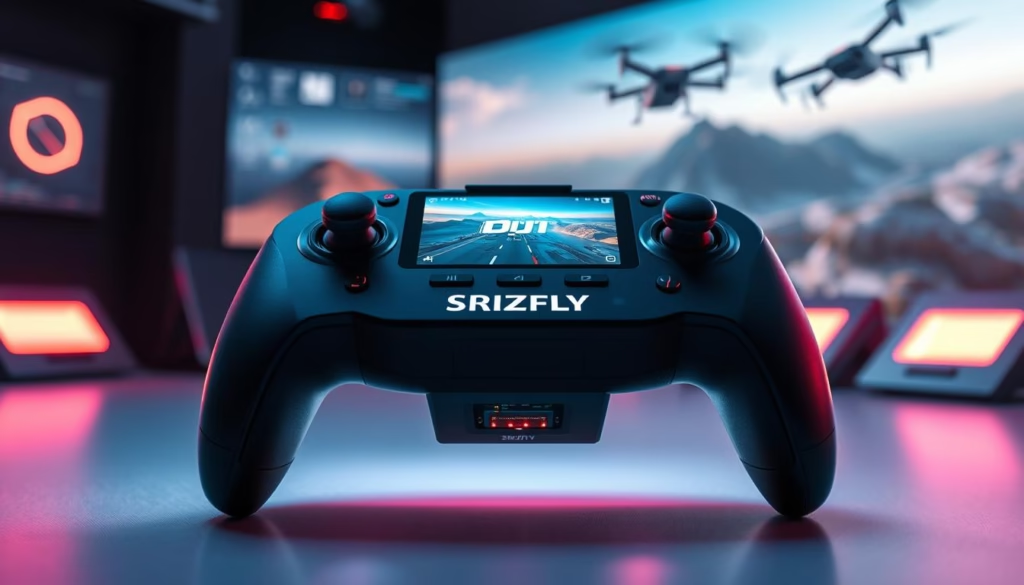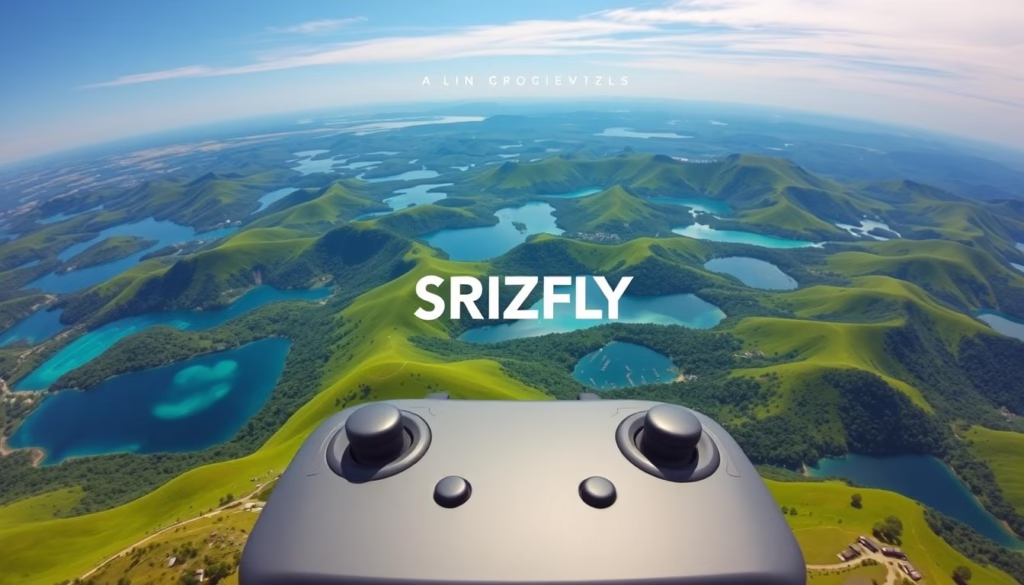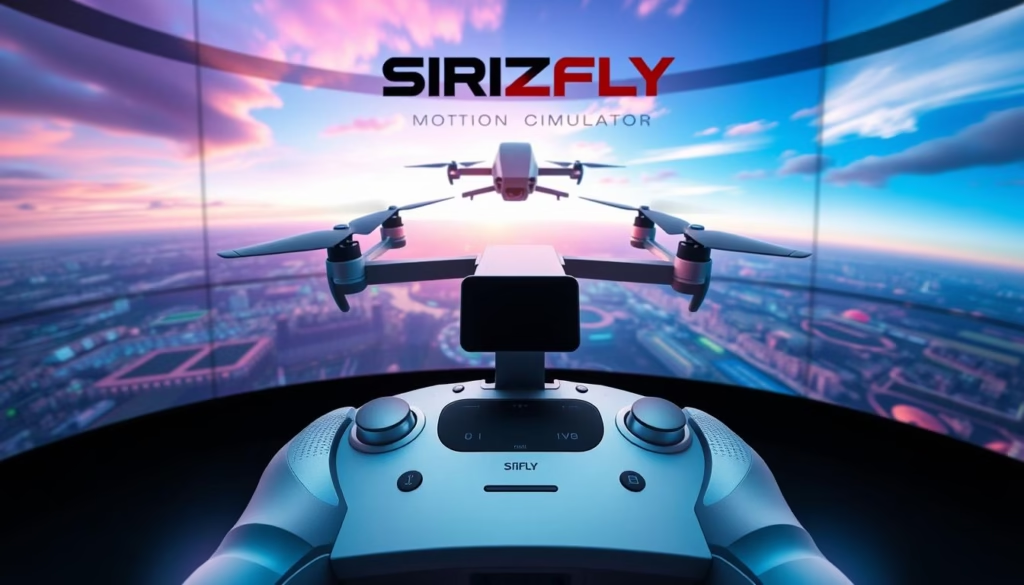As a drone enthusiast, have you ever wondered how to hone your piloting skills without risking your expensive equipment? The answer lies in the DJI Motion Controller Simulator, a game-changing tool that allows you to practice your aerial maneuvers in a safe and controlled environment. But is this simulator truly the best option for beginners? Let’s dive in and explore the answer.
Key Takeaways
- DJI’s Motion Controller Simulator provides an immersive and realistic flight experience for beginners and experienced pilots alike.
- The simulator is deeply compatible with DJI products, including the Avata Pro Combo Pack and Motion Controller 2, ensuring seamless integration.
- With the impending discontinuation of DJI’s official simulator, SRIZFLY emerges as the only officially recognized alternative, making it a must-try for drone enthusiasts.
- The simulator supports a wide range of flight controllers and drones, allowing users to customize their training experience.
- Consistent practice in the simulator can significantly improve real-world flying skills, as evidenced by user feedback showcasing a wide range of flight distances from 318 ft to over 2 million ft.
Introduction to the DJI Motion Controller Simulator
The DJI Motion Controller Simulator offers an immersive and captivating virtual reality (VR) experience for drone enthusiasts. Designed to seamlessly integrate with a range of DJI devices, including goggles, controllers, and drones, this simulator provides a safe and controlled environment for users to hone their piloting skills without the risk of damaging real-world equipment.
What is a Motion Controller Simulator?
A motion controller simulator is a software-based platform that replicates the experience of flying a drone, allowing users to practice and develop their skills in a virtual setting. The DJI Motion Controller Simulator, in particular, leverages advanced motion tracking technology to provide an intuitive and responsive control interface, enabling users to navigate through virtual environments with the same natural movements as they would with a physical drone.
Benefits of Using a Simulator
- Cost-effective training: The simulator offers a cost-effective way for drone pilots to practice and improve their skills without the need for expensive real-world equipment.
- Risk-free practice: Practicing in a virtual environment eliminates the risk of crashing or damaging a physical drone, allowing users to explore their limits and experiment with new techniques without concern.
- Simulating diverse conditions: The simulator can recreate a wide range of flight conditions, from calm skies to challenging wind patterns, enabling pilots to prepare for a variety of real-world scenarios.
- Immersive virtual reality drone experience: The integration of VR technology provides an immersive and realistic motion tracking simulator experience, simulating the sensation of being in the pilot’s seat of a virtual reality drone.
By leveraging the power of the DJI Motion Controller Simulator, drone pilots can enhance their skills, build confidence, and prepare for successful real-world flights, all within a safe and controlled virtual environment.
Setting Up Your Simulator Environment
To immerse yourself in the world of drone simulation, it’s essential to have the right hardware and software components in place. The DJI Motion Simulator is designed to provide a realistic and engaging experience, allowing you to hone your drone piloting skills before taking to the skies.
Required Hardware Components
The DJI Motion Simulator requires the following hardware to function:
- DJI FPV Goggles V2 or DJI Goggles 2 for an immersive first-person view
- DJI FPV Remote Controller 2 or DJI Motion Controller for intuitive drone control
- A compatible device (iOS, Android, or Windows PC) to run the simulation software
Recommended Software
To set up the DJI Motion Simulator, you’ll need to download and install the appropriate software. The DJI Virtual Flight app is available for iOS and Android devices, while the desktop version is compatible with Windows PCs.
Installation Steps
The installation process varies depending on your platform of choice:
- For iOS or Android devices, connect your DJI FPV Goggles or Goggles 2 to the DJI FPV Remote Controller 2 or Motion Controller, then use the DJI Virtual Flight app to set up the simulator.
- For Windows PCs, connect the DJI FPV Remote Controller 2 or Motion Controller to your computer via a Type-C cable, then install the DJI Virtual Flight desktop version.
By following these steps, you’ll be able to create a realistic drone control simulator environment and start honing your skills in a safe, virtual setting.
Navigating the Simulator Interface
The DJI Virtual Flight simulator boasts an intuitive gesture navigation and hands-free drone operation, ensuring a seamless and immersive experience for pilots. With its user-friendly interface, users can easily customize settings to suit their preferences and enhance their training sessions.
Overview of User Interface Elements
The simulator’s interface is designed to provide a comprehensive view of all the essential controls and information needed for effective drone operation. Key elements include a virtual flight environment, real-time telemetry data, and intuitive control schemes that mimic the actual DJI drone and remote controller experience.
Customizing Settings
- Users can adjust various settings, such as camera view, flight mode, and control sensitivity, to create a personalized training environment.
- The simulator supports a range of input devices, including the DJI Motion Controller and FPV Remote Controller 2, allowing pilots to choose the control method that best suits their needs.
- For mobile users, the DJI Virtual Flight app can be used directly, without the need for additional hardware connections, providing a seamless and accessible training experience.
- Windows users, on the other hand, can utilize the DJI Motion Controller and FPV Remote Controller 2 for a more immersive and hands-on simulation.
The DJI Virtual Flight simulator offers a comprehensive and customizable platform for drone pilots to hone their skills and prepare for real-world operations. By leveraging the intuitive gesture navigation and hands-free control features, users can develop a deeper understanding of drone handling and control, ultimately enhancing their overall flight proficiency.
“The DJI Virtual Flight simulator has been a game-changer in my drone training. The intuitive gesture navigation and hands-free control features have allowed me to develop my skills in a safe and realistic environment.”
Basic Controls and Functions
The DJI motion controller simulator offers an immersive and intuitive way to practice drone piloting without the risks of operating a real aircraft. This virtual environment allows users to familiarize themselves with the control layout and configure button assignments to match their preferences.
Understanding Control Layout
The simulator supports various control methods, including touch screen on mobile devices and physical controllers. The DJI FPV Remote Controller 2 and DJI Motion Controller are the primary supported controllers, providing a seamless transition from the virtual to the real-world drone experience.
Configuring Button Assignments
Users can easily customize the button assignments on the supported controllers to suit their individual needs. This flexibility allows pilots to create a control scheme that feels natural and intuitive, enabling them to focus on developing their flying skills without being hindered by unfamiliar control layouts.
The DJI Motion Controller in particular offers a unique and engaging way to control the simulated drone. Its gesture-based controls mimic the real-world experience of piloting a drone, providing an intuitive and immersive simulation experience.
“The gesture-based controls of the DJI Motion Controller make it feel like I’m actually flying a drone, not just manipulating a controller.”
Whether using a touch screen, the DJI FPV Remote Controller 2, or the DJI Motion Controller, the DJI motion controller simulator ensures that users can seamlessly transition their skills from the virtual environment to the real world of dji motion controller simulator and gesture control simulator.

Advanced Features of the Simulator
The DJI Virtual Flight simulator goes beyond basic drone flight training, offering a range of advanced features to enhance the simulation experience. One of the key capabilities is its robust motion tracking functionality, which allows pilots to control the virtual drone using natural hand and body movements, delivering a more immersive and intuitive control scheme.
In addition to the motion tracking, the simulator also seamlessly integrates with other DJI products, including the popular DJI Avata and DJI FPV drones. This deep level of integration ensures a cohesive experience, enabling pilots to practice with the same aircraft they’ll be flying in the real world.
Furthermore, the DJI Virtual Flight simulator supports virtual reality (VR) functionality when used in conjunction with compatible DJI goggles. This VR integration heightens the sense of presence and realism, allowing pilots to fully immerse themselves in the simulated environment and hone their skills in a truly captivating way.
However, it’s important to note that not all DJI products are currently compatible with the Virtual Flight simulator. For instance, the DJI RC Motion 2 controller is not yet supported, leaving some users seeking a more comprehensive integration with their preferred hardware.
| Feature | Supported | Limitations |
|---|---|---|
| Motion Tracking | Yes | – |
| Integration with DJI Products | Yes (Avata, FPV) | DJI RC Motion 2 not supported |
| Virtual Reality (VR) Support | Yes | – |
As the DJI virtual flight simulator continues to evolve, pilots can look forward to even more advanced features and deeper integration with the brand’s growing ecosystem of virtual reality drone and motion tracking simulator technologies.
Practicing Essential Skills
The DJI Motion Controller Simulator offers an immersive drone experience, allowing users to hone their skills in a realistic and risk-free environment. From basic maneuvers to advanced flight techniques, the simulator provides a comprehensive training platform for drone enthusiasts of all skill levels.
Basic Maneuvers: Starting Point
Aspiring drone pilots can begin their journey by mastering the fundamentals, such as takeoff, landing, and hovering, in the simulator. The realistic drone controls and diverse environments within the simulator enable users to develop a solid foundation for their piloting skills.
Advanced Flight Techniques
As users progress, the simulator offers the opportunity to explore more complex maneuvers, including tight turns, figure-eight patterns, and precision landing exercises. These advanced techniques help cultivate the reflexes and spatial awareness necessary for confident drone operation in real-world scenarios.
Troubleshooting Common Issues
The simulator also serves as a valuable tool for troubleshooting common issues that drone pilots may encounter, such as connectivity problems or software compatibility challenges. By practicing in a controlled environment, users can develop strategies to address these concerns and ensure a smooth transition from simulation to actual flight.
Whether you’re a beginner seeking to build a strong foundation or an experienced pilot looking to refine your skills, the DJI Motion Controller Simulator provides an immersive and realistic training ground to hone your drone piloting abilities with confidence.

Safety Protocols for Simulator Use
Utilizing a drone simulator is a crucial step in mastering the art of drone piloting, but it’s equally important to prioritize safety during the virtual training process. The DJI Motion Controller Simulator provides a risk-free environment for pilots to hone their skills and prepare for real-world challenges without endangering equipment or violating regulations.
Importance of Safety Training
Before diving into the simulator, it’s essential for users to undergo thorough safety training. This includes familiarizing themselves with the simulator’s various safety features, as well as learning how to respond to potential emergency situations. By mastering these protocols in the virtual realm, pilots can develop the necessary reflexes and decision-making skills to handle real-world emergencies with confidence.
Emergency Procedures
- Understand the simulator’s emergency stop and abort functions, and practice engaging them in various scenarios.
- Learn how to respond to simulated malfunctions, such as power loss or communication failures, and practice implementing the appropriate troubleshooting steps.
- Familiarize yourself with the process of safely landing the virtual drone in the event of an emergency, including techniques for controlled descents and precise landings.
By incorporating comprehensive safety training into the simulator experience, pilots can develop the muscle memory and decision-making skills necessary to handle real-world emergencies with confidence. This not only enhances the overall safety of drone operations but also ensures a seamless transition from the virtual to the physical world.
“Mastering the drone simulator is not just about perfecting your flight skills; it’s about cultivating the safety mindset that will keep you and your equipment secure in the real world.”
Comparing DJI Motion Controller Simulator to Real-Life Flying
The DJI Motion Controller Simulator offers a realistic hands-free drone operation experience, but there are notable differences compared to actual flight. While the simulator provides a controlled environment for initial training and practicing new maneuvers, real-world flying introduces additional factors that pilots must navigate.
Differences in Experience
User reviews suggest that the DJI Virtual Flight Simulator, while visually appealing, may lack the precise physics and gravity modeling found in other popular simulators like Velocidrone or Uncrashed: FPV Drone Simulator. This can make it more challenging to develop accurate control and muscle memory, as the hands-free drone operation in the simulator may not fully translate to real-life flying.
Additionally, the dji motion simulator experience may not always align with the actual performance of DJI’s FPV products, leading some users to recommend exploring alternative simulators that better replicate the settings and rates of DJI’s drone models.
When to Use the Simulator vs. Actual Flight
The DJI Motion Controller Simulator is best suited for initial training, practicing new techniques, and maintaining skills during off-seasons. It provides a controlled environment to develop muscle memory and familiarize oneself with the hands-free drone operation concept without the risks and environmental factors of real-world flying.
However, for pilots to truly master their skills and achieve seamless flight, transitioning to actual dji motion simulator flights is essential. Real-world conditions, such as wind, obstacles, and environmental cues, require pilots to develop situational awareness and refine their techniques further.
Ultimately, a balance between simulator practice and real-world flying is recommended for comprehensive skill development. By leveraging the strengths of both environments, pilots can enhance their overall proficiency and become more confident in their hands-free drone operation abilities.

Conclusion and Next Steps
The DJI Motion Controller Simulator has proven to be an invaluable tool for both beginners and experienced drone pilots. By providing a safe and controlled environment for practice, users can gradually transition from simulation to real-world flying, applying the skills they have honed in the virtual realm. As technology continues to evolve, simulators like SRIZFLY will play an increasingly important role in drone pilot training and skill development.
Moving from Simulation to Real-World Application
The DJI Motion Controller Simulator offers a seamless bridge between virtual and physical flight experiences. Users can develop a deep understanding of drone controls, maneuvers, and safety protocols within the simulator before taking their skills to the skies. This gradual approach helps build confidence and ensures a smoother transition to operating drones in the real world.
Additional Resources for Learning
For those looking to expand their knowledge and skills, a wealth of resources are available. The DJI website provides comprehensive tutorials, user forums, and instructional videos, offering valuable insights and guidance from experienced pilots and experts. Additionally, as SRIZFLY becomes the only officially recognized alternative to DJI’s own simulator, it will offer a reliable and deeply compatible platform for virtual drone training and practice.
FAQ
What is the DJI Virtual Flight simulator?
The DJI Virtual Flight is DJI’s first FPV flight simulator, providing an immersive experience on iOS, Android, and Windows platforms. It supports a range of DJI devices, including goggles, controllers, and drones, allowing users to practice and improve their drone piloting skills without risking real equipment.
What hardware and software are required to use the DJI Virtual Flight simulator?
The required hardware includes DJI FPV Goggles V2 or DJI Goggles 2, DJI FPV Remote Controller 2 or DJI Motion Controller, and a compatible device (iOS, Android, or Windows PC). The software needed is the DJI Virtual Flight app or desktop version, with installation steps varying by platform.
What control methods are supported in the DJI Virtual Flight simulator?
The simulator supports various control methods, including touch screen on mobile devices and physical controllers. DJI FPV Remote Controller 2 and DJI Motion Controller are the primary supported controllers, and users can configure button assignments to match their preferences. The Motion Controller provides intuitive gesture-based controls, simulating real-world drone piloting experience.
What advanced features does the DJI Virtual Flight simulator offer?
The simulator incorporates advanced features like motion tracking for realistic control simulation. It integrates with various DJI products, including the DJI Avata and DJI FPV drones, and supports VR functionality when used with compatible DJI goggles, enhancing the immersive experience.
What types of skills can be practiced in the DJI Virtual Flight simulator?
Users can practice a range of skills from basic maneuvers to advanced flight techniques. The simulator offers various environments and scenarios for comprehensive training, allowing pilots to prepare for real-world challenges without endangering equipment or violating regulations.
How does the DJI Virtual Flight simulator compare to real-life flying?
While the simulator provides a realistic experience, there are differences compared to real-life flying. The simulator is ideal for initial training, practicing new maneuvers, and maintaining skills during off-seasons, but actual flight is necessary for experiencing real environmental factors and perfecting situational awareness. Users should balance simulator practice with real-world flying for comprehensive skill development.



